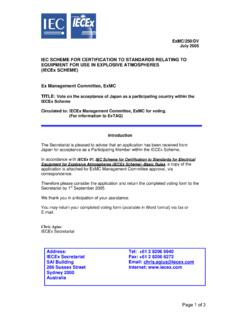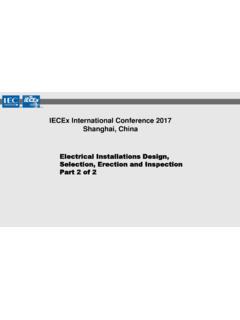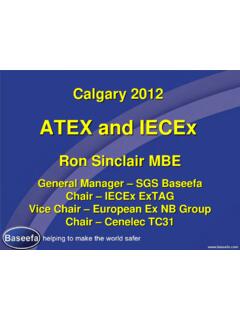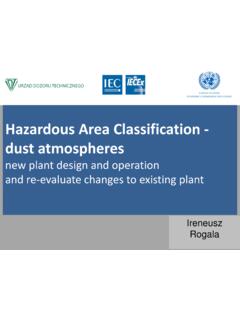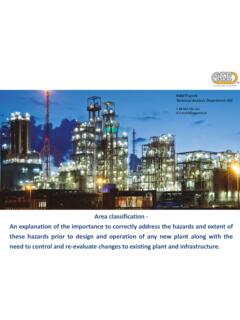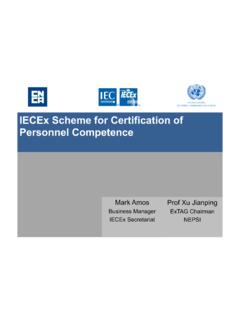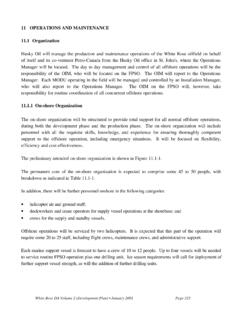Transcription of Day 2 0830-0915 IECEx Dubai Area Classif final Leroux P
1 Area ClassificationWhy ? Where ? How ? Who ? When ? Patrick LerouxTOTALAREA CLASSIFICATION Why ? A brief history of accidents ththSevere accidents in coal mines occurred through the world in the 19th and 20thcentury (thousands of casualties).Causes: result of ignitionofFire dampby sparks (often generated by electricalCauses: result of ignition of Fire damp by sparks (often generated by electrical apparatus) leading to those catastrophic accidents . IECEx Dubai 20 21/03/2012 CLASSIFICATION Why ? Abrief history of accidents Oil & gas and chemical industries also generated many accidents (fire ,explosion). Safety problems related to the design and use of electrical apparatus in hazardous areas have led theAuthoritiesat a very early stage to imposevery strict rulesareas have led the Authorities, at a very early stage to impose very strict Dubai 20 21/03/2012 CLASSIFICATION Why ?)
2 Fire , Explosion origin FIRE TRIANGLEHEXAGON EXPLOSIONS ource of ignition (heat)Gas or Dust inExplosivitylimitssuspensionlimitsFuelO xygen in air -If any side of the triangle is missing , a fire cannot existIfanysideof the triangleisremovedthefirewillextinguishIE CEx Dubai 20 21/03/2012 methods are based on the removal of one summit of the triangle/hexagon. Concentration-If anysideof the triangle isremoved, the firewillextinguishAREA CLASSIFICATIONWhy ?Area classification objectives In a situation in which there may be an explosive (flammable) atmosphere , the following steps should be taken:a) eliminate the likelihood of an explosive gas atmosphere occurring around the source of ignition, orb) eliminate the source of ignition. Whthi itiblttiittddhld bWhere this is not possible, protective measures, process equipment, systems and procedures should be selected and prepared so the likelihood of the coincidence of a) and b) is so small as to be acceptable.
3 Areaclassification:method ofanalysingand classifying the environment where Area classification :method of analysingand classifying the environment where explosive gas atmospheres may occur so as to facilitate the proper selection and installation of equipmentto be used safely in that environment. Allowspreparation of safety proceduresfor plant operation and maintenance. The area classification process reduces the overall installation risk level thh d iitIECEx Dubai 20 21/03/2012 design CLASSIFICATION Where ? Included as per IECEx Oil & gas production and processing plants :-onshore -offshore : platforms, FPSO (Floating production storage offloading vessels) Oil and gas tankers, drilling ships gg Oil refineries Petrochemical and Chemical processing plants Gas pipelines and distribution centers Re-fuelling stations or petrol stations Underground coal mines Printing industries, paper and textiles Hospital operating theatres Surface coating industries Sewerage treatment plants Grain handling and storage and processing (flour-milling industry) Sugar refineries Light metal working, where metal dust and fine particles can appear Woodworking areasIECEx Dubai 20 21/03/2012 CLASSIFICATION Where ?
4 Excluded as per IEC 60079-10-1 IEC 60079-10-1 Classification of areas - Explosive gas atmospheresStandard intended to be applied where there may be an ignition hazard due to the presence of flammable gas orvapour, mixed with air under normalatmosphericpresence of flammable gas or vapour, mixed with air under normal atmospheric conditions but does not apply to : mines susceptible to firedamp, but IEC 60079 series apply to mines (gas group I)idf fli processing and manufacture of explosives. areas where a hazard may arise due to the presence of combustible dusts or fibers (refer to IEC 61241-10 / IEC 60079-10-2). catastrophicfailures which are beyond the concept of abnormality dealt with in thiscatastrophic failures which are beyond the concept of abnormality dealt with in thisstandard.
5 Rooms used for medical purposes. domestic Dubai 20 21/03/2012 This standard does not take into account the effects of consequential CLASSIFICATION How ? RulesRules to be applied for area classification are divided into 2 categories :REGULATIONS- Published by the national legal mandatory(Law)-Application is mandatory.(Law)-They vary from country to by a standardization committee (international/national/regional). Application is not mandatory but only if it has been enforced by committees generally include representatives from : * manufacturers, *endusers end users, * safety agencies, certifying agencies* utilities, etc. They publish a document (the STANDARD ) which represents a consensus between all the parties and reflects the state of the art at a given time Consensus does not imply unanimity !
6 IECEx Dubai 20 21/03/2012 CLASSIFICATIONHow ?Reference documents oGenerally regulations give few details about on How to achieve safety but only aims are defined .REGULATIONSREGULATIONS International level .. nothing so far ..but .. ! Regional level (eg Europe).. 2 ATEX directives (1 for products , 1 for workers) Ntill l(USA)OSHA MOSHA US Ct Gd National level (egUSA).. OSHA ,MOSHA , US Coast Guards oDetails are most of time found in Standards which can be of different types :STANDARDS International IEC 60 079 seriesECENELEC 60 079i European CENELEC 60 079 series National USA : ANSI/API RP 505 (zone system)Russia : Gost R 51330-X-99 series 9 IECEx Dubai 20 21/03/2012 CLASSIFICATION How ?
7 Available IEC standards IEC 60 07910 Explosive atmospheresstandardIEC 60 079 -10 Explosive atmospheres standardPart 10-1: Classification of areas Explosive gasatmospheresPart 10-2: Classification of areas Combustible dustatmospheresPart 10-1 IntroductionstipulatesPart 10-1 Introduction stipulates In areas where dangerous quantities and concentrations of flammable gas, vapouror mist under normal atmospheric conditions may arise, protective measures are to be applied in ordertoreducethe riskoffire and/or explosionto be applied in order to reduce the risk of fire and/or 10-1 scope stipulates :For detailed recommendations regarding the extent of the hazardous areas inFor detailed recommendations regarding the extent of the hazardous areas in specific industries or applications, reference may be made to national or industry codesrelating to those Dubai 20 21/03/2012 CLASSIFICATION How ?
8 CodesCODEE xample 1 Model CODE of safe practice Part IP 15 (UK) published by the Energy Institute (formerly Institute of Petroleum ) Title : Area Classification code for installations handling flammable fluids The 3rd edition ( 2005 )-143 pages-was prepared by about 15 major oil companies The 3rd edition ( 2005 ) 143 pageswas prepared by about 15 major oil companies It is considered as a well established, internationally accepted code for classification of hazardous areas In the foreword, it is written: The information contained in this publication is provided for information only and while every reasonable care has been taken to ensure the accuracy of its contents, the EI cannot accept any responsibility for any actions taken, or not taken, on the basis of this information The EI shall not be liable.
9 IECEx Dubai 20 21/03/2012 CLASSIFICATION How ? CodesCODEE xample 2 The European Commission (publisher of the 2 ATEX directives ) has also publisheda document titled : Non binding guide of good practicefor implementing Directive n 1999/92/EC Non binding guide of good practice for implementing Directive n1999/92/EC(User directive ) which addresses area classification The ATEX User directive is an 8 pages document (the law )but the non binding guide is a 65 pages document !CODEE xample 3 API RP 505 Recommended Practice for classification of locations for ElectricalAPI RP 505 Recommended Practice for classification of locations for Electrical Installations at Petroleum facilities classified as Class I, zone 0, zone1, zone2 Foreword states : API publications may be used by anyone desiring to do so.
10 Every effort has been made by the Institute to assure the accuracy and reliability of the datacontained in them ; however the Institute makes noto assure the accuracy and reliability of the data contained in them ; however the Institute makes no warranty or guarantee in connection with this publication and expressly disclaims any liability or responsibility for loss or damage resulting from its standard is not intended to obviate the need for applying sound engineering judgement .. IECEx Dubai 20 21/03/2012 CLASSIFICATIONHow ?Which code to select ? Selection of a code to be applied (API,IP15,etc ) for a project depends on a Companydecision. The codesappliedmaydependonthetypeoffaciliti es( offshore ,refinery,..). The codes appliedmaydependon the type of facilities( offshore , refinery.)
